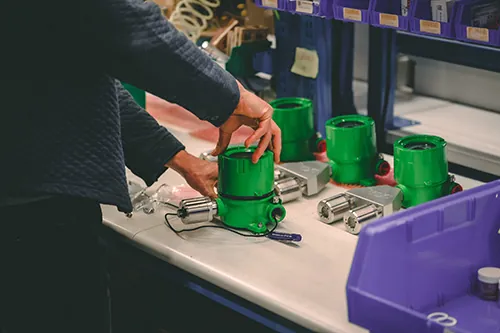Carbon monoxide (CO) is a silent killer. This colorless, odorless gas is responsible for hundreds of deaths and non-fatal poisonings in the United States each year, especially in environments where combustion occurs, such as boiler rooms. It’s crucial to understand the safety regulations surrounding carbon monoxide, particularly for facilities with boilers and mechanical systems. In Texas, as part of the Texas Administrative Code, the Department of Licensing and Regulation (TDLR) has specific rules for boiler room safety, including mandatory CO detectors and systems to prevent dangerous buildups of this toxic gas.

Texas Administrative Code: Boiler Room Regulations
According to Rule §65.206 of the Texas Administrative Code, boiler rooms containing boilers that may produce carbon monoxide must be equipped with specific safety measures to protect against CO exposure. These regulations are designed to ensure the safety of individuals working around such equipment, as well as prevent potentially fatal incidents.
Here’s a breakdown of the key safety requirements for boiler rooms:
- Carbon Monoxide Detectors
-
- Mandatory Installation: Every boiler room containing one or more boilers that could produce carbon monoxide must have a CO detector with a manual reset button. This is a critical safeguard in ensuring the gas is detected before it reaches dangerous levels.
- Display and Readout: The CO detector must display the level of CO in the air in parts per million (ppm). This allows operators to continuously monitor the environment.
- Interlocking Systems
-
- If the CO level rises above 50 ppm, the CO detector must trigger an interlock system to disable the boiler’s burners. This prevents the boiler from running in unsafe conditions.
- Power Loss Protection: The system is designed to disable the burners if the CO detector loses power, ensuring that the boiler will not continue to run without safety mechanisms in place.
- Calibration and Maintenance
-
- Regular Calibration: The CO detector must be calibrated according to the manufacturer’s instructions, or at least every 18 months. This regular calibration ensures the accuracy of the readings, and records of calibration must be posted near the boiler or easily accessible for inspection.
- Exemptions
-
- These regulations apply only to boiler rooms that contain new installations or reinstalled boilers as of September 1, 2020.
The Dangers of Carbon Monoxide
Carbon monoxide is produced when fuels such as natural gas, propane, or oil do not combust completely. In a boiler room, if the combustion process is inefficient or faulty, CO can accumulate, creating a potentially hazardous environment.
Why is CO so dangerous?

- Invisible and Odorless: Without a CO detector, it’s impossible to know if you’re breathing in the gas. It can accumulate in confined spaces like boiler rooms without anyone noticing.
- Health Risks: Low-level exposure to CO can cause dizziness, headaches, nausea, and confusion. At higher concentrations, CO can lead to unconsciousness or death within minutes.
Here are the effects of varying levels of CO in the air:
- 0 ppm: Normal outdoor air
- 100 ppm: Slight headache after 1-2 hours
- 400 ppm: Dizziness, nausea, and headache after 1-2 hours; life-threatening after 3 hours
- 1,600 ppm: Dizziness, nausea, and unconsciousness within 1 hour; death within 2 hours
- 12,800 ppm: Instantaneous effects, death within 3 minutes

Why We Choose to Work with Macurco
With a legacy spanning more than five decades, Macurco has established itself as a trusted name in gas detection solutions for residential, commercial, and industrial settings. Since 1972, they’ve been at the forefront of gas monitoring, offering reliable detectors for a wide array of gases including carbon monoxide (CO).
Specific to boiler installations there are many advantages and features that Macurco provides that separate them apart from the competition:
- Easy to install, highly durable, and made in the USA.
- Multiple voltage ranges to account for various boiler models.
- Expandable features for multiple monitors, multiple boilers, and various room sizes.
- Built in fan contactors to exhaust CO in the event of an alarm.
- Plenty of local stock for replacements and calibrations.
In addition to the above, Macurco maintains a live fire training room in Sioux Falls, SD, with all of their products to help recreate troubleshooting and wiring scenarios to assist any field technician needs.
Willbanks Install, Service & Calibration
 At Willbanks, we’re committed to keeping boiler rooms compliant, safe, and fully operational by offering comprehensive support in the installation, servicing, and calibration of gas detection systems. In response to the Texas Boiler Code requirements—mandating carbon monoxide detectors with interlock systems for boiler rooms—our team ensures proper installation of Macurco solutions, including the CM-6 CO detector and GBC controller, which are designed to disable burners when CO levels exceed 50 ppm or in the event of detector power loss.
At Willbanks, we’re committed to keeping boiler rooms compliant, safe, and fully operational by offering comprehensive support in the installation, servicing, and calibration of gas detection systems. In response to the Texas Boiler Code requirements—mandating carbon monoxide detectors with interlock systems for boiler rooms—our team ensures proper installation of Macurco solutions, including the CM-6 CO detector and GBC controller, which are designed to disable burners when CO levels exceed 50 ppm or in the event of detector power loss.
We also provide routine recalibration services or monitor replacements every 18 months, or as recommended by the manufacturer, to maintain accurate detection and uphold insurance compliance. Each recalibration is documented using our standardized form for audit and inspection readiness. With expert knowledge, proper documentation, and hands-on training, Willbanks makes gas safety easy and reliable.
Conclusion
The safety of boiler room operations should be a top priority. The Texas Administrative Code outlines essential regulations for the installation of carbon monoxide detection and shutdown systems, ensuring that facilities comply with safety standards and protect workers. By installing CO detectors, interlocking systems, and maintaining equipment, businesses can mitigate the risks associated with carbon monoxide and combustible gases, protecting both their personnel and their assets from the dangers of CO poisoning and gas explosions.


